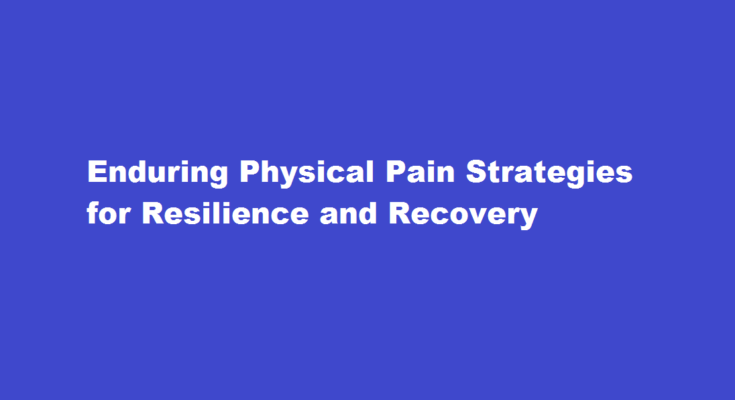Introduction
Physical pain is an inevitable part of the human experience. Whether it’s caused by injury, illness, or medical procedures, enduring pain can be challenging both physically and emotionally. However, it is crucial to understand that pain is a natural signal from our bodies, indicating that something is wrong. While it may not always be possible to completely eliminate pain, there are effective strategies to help endure and manage it. In this article, we will explore various techniques to cope with physical pain, promoting resilience and aiding in the recovery process.
Understanding Pain Perception
Before delving into coping mechanisms, it’s essential to comprehend how pain works. Pain is a complex interplay of biological, psychological, and social factors. The brain interprets pain signals and assigns an emotional response to it. Being aware of this process can empower individuals to manage their pain better. Acceptance and understanding that pain is a natural phenomenon can reduce anxiety and fear, making it easier to cope.
Deep Breathing and Relaxation Techniques
Deep breathing and relaxation exercises can be powerful tools for enduring physical pain. Techniques like mindfulness meditation, progressive muscle relaxation, and guided imagery can help calm the nervous system, leading to a reduction in pain perception. Practicing these techniques regularly can improve pain tolerance and overall well-being.
Distraction and Visualization
Distracting oneself from pain can be surprisingly effective. Engaging in activities that require concentration, such as reading, watching a movie, or playing a game, can shift focus away from pain. Visualization is another technique that can help. By imagining a pleasant and serene place, the mind can create a temporary escape from discomfort, fostering a sense of calm.
Support System and Communication
Having a supportive network of friends, family, or a support group can be immensely beneficial for those enduring physical pain. Sharing feelings and experiences with empathetic individuals can provide emotional relief and offer valuable insights. Additionally, communicating openly with healthcare providers about pain levels and concerns can lead to better pain management strategies.
Utilizing Heat and Cold Therapy
Applying heat or cold to the affected area can offer significant relief. Warm compresses or heating pads can help soothe sore muscles and promote relaxation. On the other hand, cold packs can reduce inflammation and numb the area, alleviating acute pain. However, it’s essential to use these therapies cautiously and follow appropriate guidelines to avoid tissue damage.
Physical Therapy and Exercise
In some cases, physical therapy and exercise can aid in pain management and recovery. A qualified physical therapist can design a tailored program to improve flexibility, strength, and overall function. Exercise releases endorphins, the body’s natural painkillers, which can provide temporary relief from chronic pain and elevate mood.
Pain Medication and Alternative Therapies
In cases of severe pain, medication prescribed by a healthcare professional may be necessary. While pain medication can be effective, it is essential to use them responsibly and under medical supervision. Additionally, alternative therapies such as acupuncture, chiropractic care, and massage therapy have shown promise in managing pain and enhancing well-being for many individuals.
Cognitive Behavioral Therapy (CBT)
Cognitive Behavioral Therapy is a psychological approach that can be effective in managing chronic pain. CBT helps individuals identify negative thought patterns and develop healthier coping mechanisms. By altering perceptions and reactions to pain, CBT empowers individuals to regain control over their lives despite their physical challenges.
Rest and Sleep
Proper rest and sleep are essential for the body’s healing process and pain management. Creating a conducive sleep environment, sticking to a regular sleep schedule, and practicing relaxation techniques before bedtime can improve sleep quality and aid in recovery.
Frequently Asked Questions
How do people deal with pain?
Pain medicines. physical therapies (such as heat or cold packs, massage, hydrotherapy and exercise) psychological therapies (such as cognitive behavioral therapy, relaxation techniques and meditation) mind and body techniques (such as acupuncture).
Can the human body endure pain?
Everyone’s pain tolerance is different and can depend on a range of factors including your age, gender, genetics, culture and social environment. The way we process pain cognitively affects our pain tolerance.
Conclusion
Enduring physical pain is an arduous journey, but it is possible to build resilience and find relief through various coping mechanisms. By understanding pain perception, practicing relaxation techniques, utilizing heat and cold therapy, and seeking support from a network of understanding individuals, one can navigate the challenges of pain with greater ease. Remember that every individual’s experience with pain is unique, and finding the right combination of strategies may take time. By adopting a proactive and open approach, it is possible to endure physical pain and work towards a healthier, more comfortable life.
Read Also : A Comprehensive Guide How to Transfer Money from Credit Card



